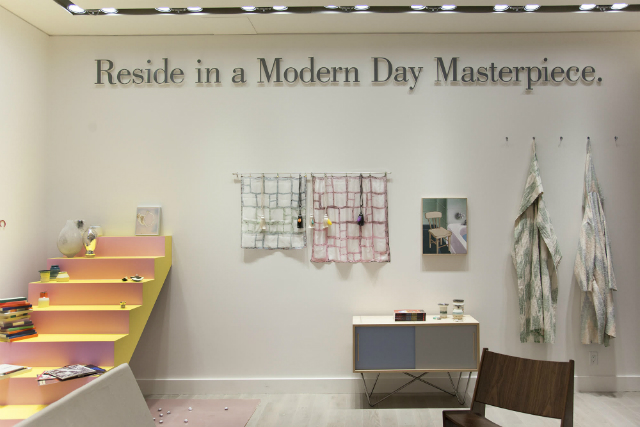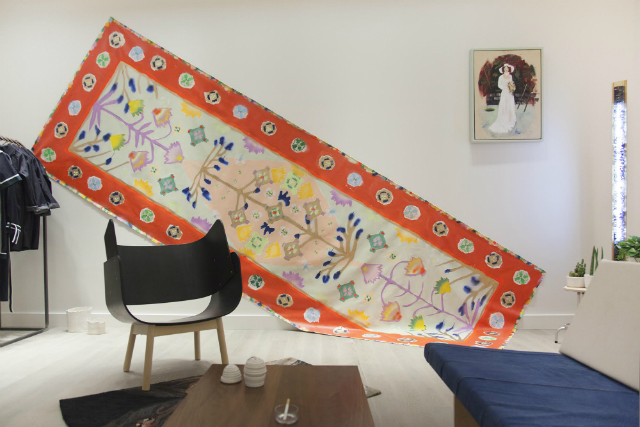
Installation view of Chroma Lives. Credit: Lili Huston-Herterich
Chroma Lives
Curated by Erin Alexa Freedman and Lili Huston-Herterich
The New Residences of Yorkville Plaza (21 Avenue Road)
On now until June 30
Artists: Joshua Brolly, Connor Crawford, Laura Dawe, Mike Goldby, Heather Goodchild, Oliver Husain, Tim Jocelyn, Laurie Kang, Jeremy Laing, Brittany MacDougall, Tammy McClennan, Pasha Moezzi, Manden Murphy, Roula Partheniou, Shakeel Rehemtulla & Dynasty, Wanze Song, Kristian Spreen and Brad Tinmouth
The Yorkville neighborhood is to Toronto what the Upper East Side’s Park Avenue is to New York. In a word: bougie. Back in the 1960s, it looked considerably different; as Canada’s equivalent to Greenwich Village, it was known for its waify bohemians, coffee house folk scene and a gallery district anchored by influential commercial gallerists like Walter Moos and Mira Godard. But offices and hotels were eventually built, followed by high-priced condo developments amongst the still remaining Victorian rowhouses now listed for over a million each. Yorkville’s biggest attraction is now it’s “Mink Mile”, a high-end luxury shopping strip that caters to the affluent residents of Rosedale and Forest Hill.
Given all this, perhaps it’s not surprising that at first glance, one could mistake the group exhibition Chroma Lives for an interior design showroom. Located in the presentation center for the Yorkville Plaza condo development on Avenue Road, curators Erin Alexa Freeman and artist Lili Huston-Herterich have filled the space with household items like walnut furniture, succulents planted in unglazed ceramic pots, and clothing hung on a rack. Not much distinguishes this simulacrum of affluence from present-day realities, especially at a time when luxury real estate has been engineered to include art walls and humidity systems to attract art-centric buyers.

Installation view of Chroma Lives. Credit: Lili Huston Herterich
This chameloid approach to curating includes art that imitates, parodies and even knocks off this approximation of aspirational condo living—but with uneven success. The most direct piece — a wall-mounted text phrase, “Reside in a Modern Day Masterpiece” — is actually part of the showroom. The text piece alludes to an uneasy, even arguably suspicious tone to the rest of the works in the showroom space, which seem to skewer the trappings of new wealth, but don’t offer a critique much past that. In the context of a gentrified neighborhood, is a kind of passing criticality enough?
Take for instance, the array of art objects that seemed to be included for their allusion to social climbing and aspirational wealth, and the subtle digs therein. A window, is represented by a Oliver Husain painting of one on silk; the curtain tassels, however, are nouveau riche gauche, accented with kitschy dollar store plastic hot dogs and corn. There are fake wooden Penguin-esque book stacks alongside real books by Roula Partheniou, who is known for her exact renderings of everyday objects. The stack is artfully arranged alongside other books and objects on a pink and yellow Memphis-esque step end table by Manden Murphy, and evoke the uncut pages of Gatsby’s library. The general sense given is that beneath the veneer of Keeping-up-with-the-Joneses domesticity lies a concept that’s been largely unexamined.
Why is this project, in this neighborhood, addressing these issues? No explanation is offered. Instead, we’re asked to look at the show as also the staging of a collection of archival documentation tied to Chromaliving, an early 1980s artist-organized show that took over a vacant retail space at Bloor Street’s nearby Colonnade. Akin to Colab’s 1980 The Times Square Show, over 100 local artists — most of whom were part of the then burgeoning Queen Street scene, which was defined by its intermingling of the art, music and fashion scenes — created rooms and furnishings. The tone was lurid, garish and over-the-top; organized by figurative art collective ChromaZone, the show featured works by General Idea and then-emerging artists like hyperrealistic sculptor Evan Penny, “practiques relationalles” collective FASTWÜRMS, feminist performance and video artist Tanya Mars, and more. Fashion shows, screenings and performances were staged during the exhibition’s month-long run.

Detail Manden Murphy’s “Stairs” with Roula Partheniou’s “Book Stack” and various archival materials from the original Chromaliving show. Credit: Lili Huston-herterich
According to the curatorial statement for Chroma Lives, the site is a “workspace” for the curators to conduct recorded interviews with Chromaliving’s “participants, spectators and critics.” (It’s worth noting, however, that these interviews happen during the show’s off-hours, and won’t be made available until an online archive comes to fruition.) Chroma Lives’s past permeates like a choking cloud of dust. The books on the Murphy’s side-step table are a collection of various research ephemera from the era. A flat screen television cycles through digitized color slides, where connections between the past and present become more pronounced. Brad Tinmouth’s “Standing Lamp”, a grow lamp scrawled with black sharpie set on a concrete stand, echoes David Clarkson’s “Lamp” installation. The day-glo spraypainted hue of Laura Dawe’s rug, asymmetrically half hung on the wall onto the floor, recalls David Buchan’s “From the Archive of Lamonte del Monte” and its shrunk-wrapped club gear. Prevalent in all the works is the sense of the grimey lived experiences of the participating Queen Street artists.
It’s all-too-easy to become enamoured with this past here, especially because it’s so removed. Only one of the past Chromaliving artists—the now deceased co-curator Tim Jocelyn — has work in the show. And if you spend some time flipping through the original exhibition catalogue, not to mention the multiple stacks of magazines and books from the era, that ghostly past comes alive in a way that overwhelms the present. Whereas the predecessor was an outright critique of retail display practices, the mimicry of Chroma Lives’s condo staging is so exact that no critique is possible. It’s simply an arrangement of perfectly tasteful objects. What is at stake or being critiqued about today’s lifestyle branding of the domestic space? As far as I can tell, not much, beyond perhaps a sense that living too much in past can make you forget what’s at stake now.


Comments on this entry are closed.